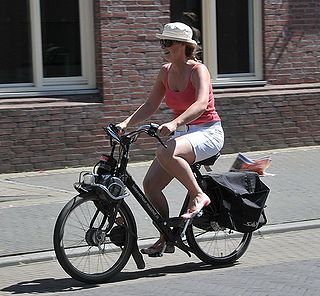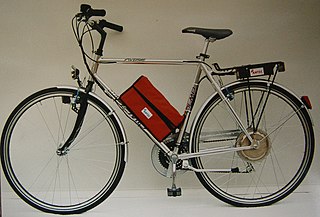
A velomobile, velomobiel, velo, or bicycle car is a human-powered vehicle (HPV) enclosed for aerodynamic advantage and/or protection from weather and collisions. Velomobiles are similar to recumbent bicycles, pedal go-karts and tricycles, but with a full fairing and are not to be confused with purpose-built mobiles for racing or speed records fully faired vehicles with two wheels, generally called streamliners. Streamliners have set many speed and distance records.

The Twike is a human-electric hybrid vehicle (HEHV) designed to carry two passengers and cargo. Essentially a velomobile with an electrical hybrid engine, it can be driven in electric-only mode or electric + pedal power mode. Pedaling warms the user, making electric heating in winter unnecessary, extends the range of the vehicle but does not substantially add to the vehicle's top speed.

Bicycle lighting is illumination attached to bicycles whose purpose above all is, along with reflectors, to improve the visibility of the bicycle and its rider to other road users under circumstances of poor ambient illumination. A secondary purpose is to illuminate reflective materials such as cat's eyes and traffic signs. A third purpose may be to illuminate the roadway so that the rider can see the way ahead. Serving the latter purposes require much more luminous flux and thus more power.

The CitiCar is an electric car produced from 1974 to 1977 by Sebring, Florida–based Sebring-Vanguard, Inc. After being bought out by Commuter Vehicles, Inc, Sebring-Vanguard produced the similar Comuta-Car and Comuta-Van from 1979 to 1982. Similarities to its exterior design can be spotted in the Danish Kewet and the later Norwegian Buddy. Accounting for all CitiCar variants, a total of 4,444 units were produced up to 1979, the most since 1945 for an electric car assembled in North America until surpassed by the Tesla Model S.

A cyclocomputer, cycle computer, cycling computer or cyclometer is a device mounted on a bicycle that calculates and displays trip information, similar to the instruments in the dashboard of a car. The computer with display, or head unit, usually is attached to the handlebar for easy viewing. Some GPS watches can also be used as display.

A motorized bicycle is a bicycle with an attached motor or engine and transmission used either to power the vehicle unassisted, or to assist with pedalling. Since it sometimes retains both pedals and a discrete connected drive for rider-powered propulsion, the motorized bicycle is in technical terms a true bicycle, albeit a power-assisted one. Typically they are incapable of speeds above 52km/h.

Brompton Bicycle is a British manufacturer of folding bicycles based in Greenford, London.

An electric bicycle is a motorized bicycle with an integrated electric motor used to assist propulsion. Many kinds of e-bikes are available worldwide, but they generally fall into two broad categories: bikes that assist the rider's pedal-power and bikes that add a throttle, integrating moped-style functionality. Both retain the ability to be pedaled by the rider and are therefore not electric motorcycles.
Many countries have enacted electric vehicle laws to regulate the use of electric bicycles. Countries such as the United States and Canada have federal regulations governing the safety requirements and standards of manufacture. Other countries like the signatories of the European Union have agreed to wider-ranging legislation covering use and safety.

Kronan bicycles are marketed by Kronan Trademark AB, also known as Kronan AB. Kronan AB was established in June 1997 by three former-students, John Wahlbäck and the Avander brothers, Henry and Martin. In autumn 2003 the company was bought by the Brunstedt family with Mary Brunstedt as the company's current CEO.

A motorized scooter is a stand-up scooter powered by a small utility internal combustion engine or, in case of e-scooter, by a small electric motor directly built in the front or the rear wheel. Classified as a form of micro-mobility, these scooters are generally designed with a large deck in the center on which the rider stands. The first motorized scooter was manufactured by Autoped beginning in 1915.

A pedelec or EPAC, is a type of low-powered electric bicycle where the rider's pedalling is assisted by a small electric motor. However, unlike some other types of e-bikes, pedelecs are classified as conventional bicycles in many countries by road authorities rather than as a type of electric moped. Pedelecs include an electronic controller which cuts power to the motor when the rider is not pedalling or when a certain speed – usually 25 km/h (16 mph) or 32 km/h (20 mph) – is reached. Pedelecs are useful for people who ride in hilly areas or in strong headwinds. While a pedelec can be any type of bicycle, a pedelec city bike is very common. A conventional bicycle can be converted to a pedelec with the addition of the necessary parts, e.g., motor, battery, etc.
Montague Corporation is an American company that designs, manufactures, and sells full-size folding bicycles. It is headquartered in Cambridge, Massachusetts.
The GreenWheel is a modular electronic assist device for bicycles that fits inside the wheel of any standard bicycle and provides additional power above and beyond the power provided by the person pedaling.

Bicycle drivetrain systems are used to transmit power on bicycles, tricycles, quadracycles, unicycles, or other human-powered vehicles from the riders to the drive wheels. Most also include some type of a mechanism to convert speed and torque via gear ratios.
The City Mantis Electric Scooter is a personal transporter developed by City Mantis USA. It is not clear when the City Mantis was first launched but its earliest appearance comes from a Cycle Show at the Business Design Centre in 2002. The original City Mantis model was known for its unique fold-up feature and was marketed for being conveniently stored or carried away after use. According to the official website, the City Mantis was voted "most innovative new product of 2003" at the time of its release.

The Copenhagen Wheel was a self-contained rear wheel electric bicycle system which transformed a traditional bicycle into a hybrid e-bike. The app-connected Wheel was equipped with an electric motor, battery, and suite of sensors that worked together to seamlessly amplify a rider's pedal power by up to ten times. The Copenhagen Wheel was developed at MIT's Senseable City Lab in 2009 in partnership with the city of Copenhagen, and unveiled at the 2009 United Nations Climate Change Conference. In December 2012, Assaf Biderman, a co-inventor of the Wheel and Associate Director of the MIT Senseable City Lab, founded Superpedestrian Inc. with an exclusive license to commercialize the Wheel. After several years of engineering, testing, and validation, the Copenhagen Wheel officially launched in the U.S. in April 2017, and in Europe in October 2017

Invalid carriages were usually single seater road vehicles, buggies, or self-propelled vehicles for disabled people. They pre-dated the electric mobility scooters and from the 1920s were generally powered by a small gasoline/petrol engine, although some were battery powered. They were usually designed without foot-operated controls.
Manulectric was a British marque of milk floats and other battery electric road vehicles. The vehicles were made by Sidney Holes Electric Vehicles, of Brighton, Sussex. They were designed out of Holes' experience of doorstep milk delivery, through Holes and Davigdor Dairies. Both pedestrian controlled vehicles (PCVs) and ride-on models were produced, and entered the market around 1947. The company was bought by Stanley Engineering in the 1960s, and sold to Crompton Electricars in 1972. Some Manulectric models were subsequently manufactured by Harbilt Electric Trucks.














